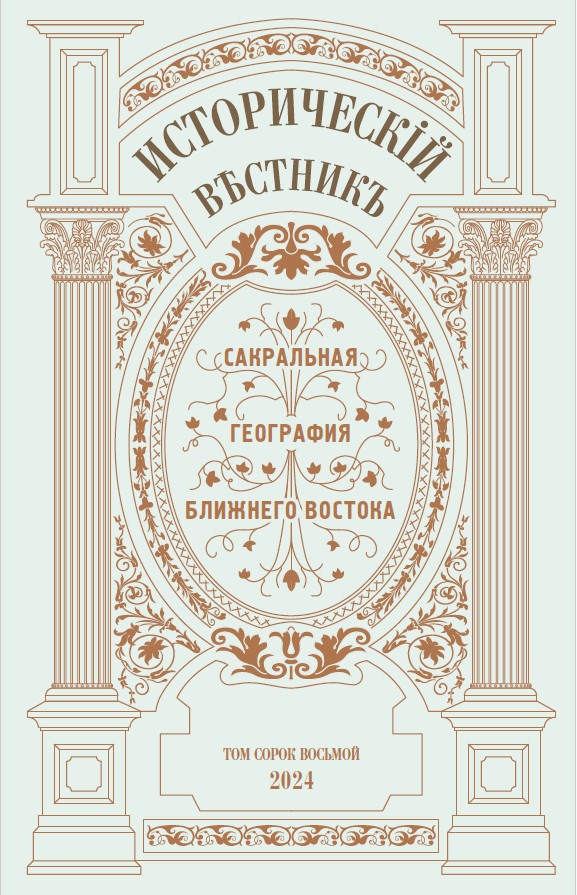
Кобищанов Т.Ю. Сакральные пространства и Восточная экспедиция Наполеона Бонапарта (1798–1801 гг.)
DOI: 10.35549/HR.2024.2024.48.012Кобищанов Т.Ю. Сакральные пространства и Восточная экспедиция Наполеона Бонапарта (1798–1801 гг.) // Исторический вестник. 2024. Т. XLVIII. С. 286–303.
Аннотация
Статья посвящена столкновению различных типов восприятия сакральных пространств на Ближнем Востоке в эпоху похода Наполеона Бонапарта в Египет и Сирию. Интегральному «актуальному» восприятию святых мест противопоставлено восприятие «мемориальное», а им обоим – «секулярное» мышление прибывших в Палестину представителей европейской цивилизации. Источником анализа стали мысли и чувства находившихся на рубеже XVIII–XIX вв. на Ближнем Востоке мусульман и христиан, османских подданных и европейцев, оставивших заметки, летописи и воспоминания на арабском, османcком, греческом, французском, английском и итальянском языках.
Ключевые слова: сакральные пространства, религиозное восприятие, святые места Палестины, борьба за святые места, Восточная экспедиция Наполеона Бонапарта.
Кобищанов Тарас Юрьевич – кандидат исторических наук, доцент кафедры истории стран Ближнего и Среднего Востока Института стран Азии и Африки МГУ имени М.В. Ломоносова.
***
Kobishchanov T.Y. Sacred Spaces and the Eastern Expedition of Napoleon Bonaparte // Historical Reporter. 2024. Vol. 48. P. 286–303.
Abstract
The article is devoted to the clash of different types of perception of sacred spaces in the Middle East during the era of Napoleon Bonaparte’s campaign in Egypt and Syria. The integral ‘actual’ perception of the holy places is opposed by the ‘memorial’ perception, and both were opposed by the ‘secular’ thinking of representatives of European civilization who arrived in Palestine. The source of the analysis was the thoughts and feelings of those who were at the turn of the 18th--19th centuries in the Middle East: Muslims and Christians, Ottoman subjects and Europeans who left notes, chronicles and memoirs in Arabic, Ottoman, Greek, French, English and Italian.
Key Words: Sacred Spaces, Religious Perception, Holy Places of Palestine, the Struggle for Holy Places, the Eastern Expedition of Napoleon Bonaparte.
Taras Y. Kobishchanov — C.Sc. (History), Associate Professor at the Department of Near and Middle Eastern History at Moscow State University, Institute of Asian and African Studies.
***
References
- Brown P. The Cult of Saints: its Rise and Function in Latin Christianity. Chicago: University Chicago Press, 1981.
- Goldziher I. The Cult of Saints in Islam // Moslem World. 1911. № 1 (1)
- 302–312.
- Kobishchanov T.Y. Vojna Enriko Frankini: rossijskij agent v osmanskom pohode na Egipet (1799–1800) [Enrico Francini’s War: a Russian agent in the Ottoman campaign against Egypt (1799–1800)] // Istoricheskij Vеstnik [Historical Reporter]. M., 2023. T. 46. P. 86–115 (in Rus.).
- Krotov A.A. Napoleon Bonapart i religiya [Napoleon Bonaparte and Religion] // Vestnik PSTGU (Pravoslavnogo Svyato-Tihonovskogo gosudarstvennogo universiteta). Seriya I. Bogosloviya. Filosofiya. Religiovedenie [Bulletin of the St. Tikhon’s Orthodox State University. Series I. Theology. Philosophy. Religious studies]. 2020. Iss. 92. P. 59–75 (in Rus.).
- Meri J.W. Re-appropriating Sacred Space: Medieval Jews and Muslims Seeking Elijah and al-Khadir // Medieval Encounters. 1999. №5. Р. 237– 264.
- Soloduhina T.G. Plany Napoleona Bonaparta v otnoshenii iudeev na Blizhnem Vostoke: mif ili real’nost’? [Napoleon Bonaparte’s plans for Jews in the Middle East: myth or reality?] // Vestnik Moskovskogo universiteta [Bulletin of the Moscow University]. Ser. 13. Vostokovedenie. 2013. №1. P. 23–35 (in Rus.).
- Vrijhof P.H., Waardenburg J. Official and Popular Religion: Analysis of a Theme for Religious Studies. The Hague: Mouton, 1979.
- Waardenburg J. ‘Official and Popular Religion in Islam // Social Compass 1978. № 25. Р. 315–341.

